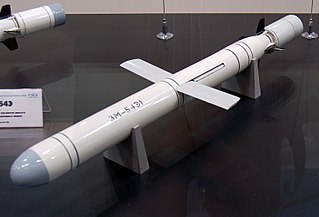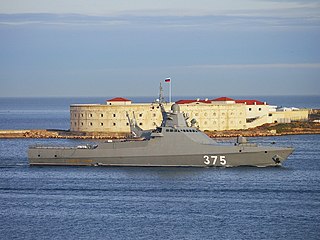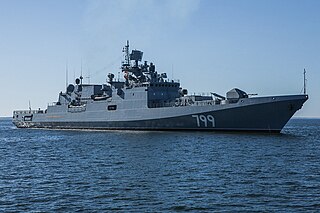
The Russian Navy is the naval arm of the Russian Armed Forces. It has existed in various forms since 1696. Its present iteration was formed in January 1992 when it succeeded the Navy of the Commonwealth of Independent States.

The Black Sea Fleet is the fleet of the Russian Navy in the Black Sea, the Sea of Azov and the Mediterranean Sea. The Black Sea Fleet, along with other Russian ground and air forces on the Crimean Peninsula, are subordinate to the Southern Military District of the Russian Armed Forces. The fleet traces its history to its founding by Prince Potemkin on 13 May 1783 as part of the Imperial Russian Navy. The Russian SFSR inherited the fleet in 1918; with the founding of the Soviet Union in 1922, it became part of the Soviet Navy. Following the collapse of the Soviet Union in 1991, the Black Sea Fleet was partitioned between the Russian Federation and Ukraine in 1997, with Russia receiving title to 82% of the vessels.

The Krivak class, Soviet designation Project 1135 Burevestnik, are a series of frigates and patrol ships built in the Soviet Union primarily for the Soviet Navy since 1970. Later some sub-branches, like the Nerey (Nereus) were designed for coastal patrol by the KGB Border Troops. Until 1977, the ships in the class were considered to be large anti-submarine warfare vessels.

The Udaloy class, Soviet designation Project 1155 Fregat and Russian designation Project 11551 Fregat-M, are series of anti-submarine guided-missile destroyers built for the Soviet Navy, seven of which are currently in service with the Russian Navy. Twelve ships were built between 1980 and 1990, while the thirteenth ship built to a modified design, known as Udaloy II class, followed in 1999. They complement the Sovremenny-class destroyers in anti-aircraft and anti-surface warfare operations. The codename Udaloy comes from a Russian adjective удалой, meaning daring or bold.

The Russian cruiser Marshal Ustinov, is a Slava-class cruiser of the Russian Navy. The Russian name for the ship type is Raketnyy Kreyser (RKR), meaning "Missile Cruiser". The ship is named after Dmitriy Ustinov, a former Soviet Minister of Defence. Marshal Ustinov was assigned to the 43rd Missile Ship Division of the Russian Northern Fleet, whose homeport is in Severomorsk. From 2012 to 2016, the cruiser underwent a major overhaul. The vessel returned to service in 2017 and has since been deployed to the Mediterranean Sea.

The Steregushchiy class, Russian designation Project 20380, is a class of corvettes being built for the Russian Navy. Designed by the Almaz Central Marine Design Bureau, subsequent vessels were built to an improved design, incorporating the Zaslon-Redut SAM system. The ship full displacement and dimensions are large for a corvette, thus it is designated as a frigate by NATO. The Steregushchiy class has been further developed into the Gremyashchiy class and Project 20386 subclasses. The export variant is known as Project 20382 Tigr.

The Novator Kalibr, also referred to as 3M54-1 Kalibr, 3M14 Biryuza, is a family of Russian cruise missiles developed by NPO Novator (OKB-8). It first saw service in 1994. There are ship-launched, submarine-launched and air-launched versions of the missile, and variants for anti-ship, and land attack use. Some versions have a second propulsion stage that initiates a supersonic sprint in the terminal approach to the target, reducing the time that air defense systems have to react, while subsonic versions have greater range than the supersonic variants. The missile can carry a warhead weighing up to 500 kilograms (1,100 lb).

Russian cruiser Varyag, formerly Chervona Ukraina, is the third ship of the Slava-class of guided missile cruisers built for the Soviet Navy now serving the Russian Navy.

The Project 22350 also known as the Admiral Gorshkov class, is a class of frigates of the Russian Navy. The ships are being built by the Severnaya Verf in Saint Petersburg at a cost of $250 million per ship. The class was designed by the Severnoye Design Bureau and incorporates use of stealth technology. As of August 2020, ten vessels have been ordered for delivery by 2027. The lead ship of the class, Admiral Gorshkov, was commissioned on 28 July 2018.

Vice-Admiral Kulakov is an Udaloy-class destroyer of the Russian Navy. As of 2022, the ship was in active service. She is named after Soviet naval officer Nikolai Kulakov.

Admiral Flota Sovetskogo Soyuza Gorshkov is an Admiral Gorshkov-class frigate of the Russian Navy and the lead ship of the class.

Admiral Flota Kasatonov is an Admiral Gorshkov class frigate of the Russian Navy and the second ship of the class.

The Admiral Grigorovich class, Russian designation Project 11356R, is a class of frigates built by the Yantar Shipyard in Kaliningrad for the Russian Navy and Indian Navy, with a cost of $450-500 million. Based on the Talwar class, six ships were ordered for the Russian Black Sea Fleet under two contracts in 2010 and 2011 as a complement to the Admiral Gorshkov-class frigates.

Project 22160 is a series of large patrol ships being constructed for the Russian Navy. The vessels are primarily intended for duties such as patrol, monitoring and protection in open and closed seas. The first ship was laid down in February 2014 and joined the Russian Navy in December 2018. By January 2018, six ships were under construction. Between 2017 and 2022, four ships had been launched.

Admiral Tributs is a Project 1155 Large Anti-Submarine Ship of the Russian Navy. Known in the west as an Udaloy-class destroyer, the ship is named after admiral Vladimir Filippovich Tributs. Launched in 1983, Admiral Tributs serves in the Russian Pacific Fleet, and has taken part in operations alongside the naval forces of other nations like China, India and Japan, and as part of a peacekeeping force in the Middle East between 1992 and 1993.

Admiral Essen is a frigate of the Admiral Grigorovich class of the Russian Navy named in honour of Admiral Nikolai Ottovich von Essen. The ship construction begun at the Yantar Shipyard in Kaliningrad in July 2011, and it was launched in November 2014. It is based with the Black Sea Fleet at Sevastopol.

Admiral Makarov is an Admiral Grigorovich-class frigate of the Russian Navy, part of the Black Sea Fleet based at Sevastopol. She was laid down at the Yantar Shipyard in February 2012 and commissioned on 25 December 2017. She is the most recently built of her class, and the third of six ships that had been planned in the class as of November 2014.

Stoikiy is a Steregushchiy-class corvette of the Russian Navy.

The permanent task force of the Russian Navy in the Mediterranean Sea is a task force of the Russian Navy responsible for projecting Russian power in the Middle East through the Mediterranean Sea.




















